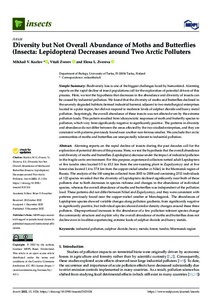Diversity but Not Overall Abundance of Moths and Butterflies (Insecta: Lepidoptera) Decreases around Two Arctic Polluters
Kozlov Mikhail V.; Zverev Vitali; Zvereva Elena L.
https://urn.fi/URN:NBN:fi-fe202301255519
Tiivistelmä
Alarming reports on the rapid decline of insects during the past decades call for the exploration of potential drivers of this process. Here, we test the hypothesis that the overall abundance and diversity of moths and butterflies (Lepidoptera) decrease under the impact of industrial pollution in the fragile arctic environment. For this purpose, experienced collectors netted adult Lepidoptera at five tundra sites located 0.5 to 45.3 km from the ore-roasting plant in Zapolyarnyy and at five forest sites located 1.4 to 37.8 km from the copper–nickel smelter at Nikel, in the Murmansk region of Russia. The analysis of the 100 samples collected from 2003 to 2008 and containing 2312 individuals of 122 species revealed that the diversity of Lepidoptera declined significantly near both of these polluters due to both decreases in species richness and changes in the abundance of individual species, whereas the overall abundance of moths and butterflies was independent of the pollution load. These patterns did not differ between Nikel and Zapolyarnyy, and they were consistent with patterns previously found near the copper–nickel smelter at Monchegorsk. The abundances of Lepidoptera species showed variable changes along pollution gradients, from significantly negative to significantly positive, but individual species showed similar density changes around these three polluters. Disproportional increases in the abundance of a few pollution-tolerant species change the community structure and explain why the overall abundance of moths and butterflies does not decline even in localities experiencing extreme loads of sulphur dioxide and heavy metals.
Kokoelmat
- Rinnakkaistallenteet [27094]
